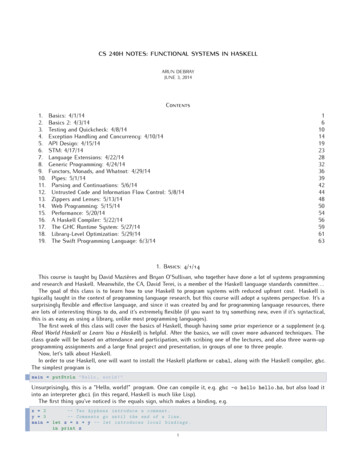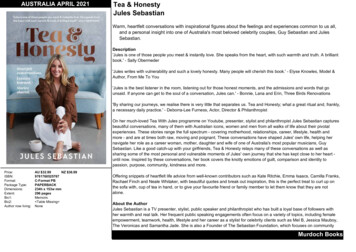
Transcription
CS 240H NOTES: FUNCTIONAL SYSTEMS IN HASKELLARUN DEBRAYJUNE 3, .17.18.19.Basics: 4/1/14Basics 2: 4/3/14Testing and Quickcheck: 4/8/14Exception Handling and Concurrency: 4/10/14API Design: 4/15/14STM: 4/17/14Language Extensions: 4/22/14Generic Programming: 4/24/14Functors, Monads, and Whatnot: 4/29/14Pipes: 5/1/14Parsing and Continuations: 5/6/14Untrusted Code and Information Flow Control: 5/8/14Zippers and Lenses: 5/13/14Web Programming: 5/15/14Performance: 5/20/14A Haskell Compiler: 5/22/14The GHC Runtime System: 5/27/14Library-Level Optimization: 5/29/14The Swift Programming Language: 6/3/141610141923283236394244485054565961631. Basics: 4/1/14This course is taught by David Mazières and Bryan O’Sullivan, who together have done a lot of systems programmingand research and Haskell. Meanwhile, the CA, David Terei, is a member of the Haskell language standards committee. . .The goal of this class is to learn how to use Haskell to program systems with reduced upfront cost. Haskell istypically taught in the context of programming language research, but this course will adopt a systems perspective. It’s asurprisingly flexible and effective language, and since it was created by and for programming language resources, thereare lots of interesting things to do, and it’s extremely flexible (if you want to try something new, even if it’s syntactical,this is as easy as using a library, unlike most programming languages).The first week of this class will cover the basics of Haskell, though having some prior experience or a supplement (e.g.Real World Haskell or Learn You a Haskell) is helpful. After the basics, we will cover more advanced techniques. Theclass grade will be based on attendance and participation, with scribing one of the lectures, and also three warm-upprogramming assignments and a large final project and presentation, in groups of one to three people.Now, let’s talk about Haskell.In order to use Haskell, one will want to install the Haskell platform or cabal, along with the Haskell compiler, ghc.The simplest program ismain putStrLn " Hello , world ! "Unsurprisingly, this is a “Hello, world!” program. One can compile it, e.g. ghc -o hello hello.hs, but also load itinto an interpreter ghci (in this regard, Haskell is much like Lisp).The first thing you’ve noticed is the equals sign, which makes a binding, e.g.x 2-- Two hyphens i n t r o d u c e a comment .y 3-- C o m m e n t s go until the end of a line .main let z x y -- let i n t r o d u c e s local b i n d i n g s .in print z1
This program will print 5.Bound names can’t start with uppercase letters, and are separated by semicolons, which are usually automaticallyinserted as above. Functions can even be bound, e.g.:add x y x yfive add 2 3-- defines f u n c t i o n add-- invokes f u n c t i o n addThis is a good way to define functions.Haskell is a pure functional language. Thus, unlike variables in imperative languages, Haskell bindings are immutable:within a given scope, each symbol can be bound only once. In other words, the following is an error:x 5x 6 -- Error , cannot re - bind xBindings are thus order-independent.Another interesting fact is that bindings are lazy: definitions of symbols are only evaluated when they’re needed. Forexample:safeDiv x y let q div x y-- safe as q isn ’ t e v a l u a t e d if y 0in if y 0 then 0 else qmain print ( safeDiv 1 0 ) -- prints 0Notice this is completely different from C-like languages!Another interesting aspect of bindings, which goes hand-in-hand with order-independence, is that bindings arerecursive, so each binding is in scope within its own definition.x 5-- not used in main !main let x x 1in print x-- i n t r o d u c e s a new x , defined in terms of itself-- loops forever , or stack o v e r f l o w sIn C, this would print 6, but here, x refers to itself! The runtime sometimes is able to detect the loop, however.This means that writing things in Haskell requires thinking differently! For example, here’s a factorial program in C:long factorial ( int n ) {long result 1 ;while ( n 1 )result * n - -;return result ;}But in Haskell, one uses recursion.factorial n if n 1 then n * factorial (n - 1 )else 1However, the C function requires constant space, but the Haskell version requires n stack frames! But Haskell supportsoptimized tail recursion; if a function ends with a call to itself (i.e. is tail-recursive), then it can be optimized into a loop.However, the definition provided above isn’t tail-recursive.Using an accumulator, the factorial function can be made tail-recursive.factorial n let loop acc n ’ if n ’ 1then loop ( acc * n ’) (n ’ - 1 )else accin loop 1 nThis uses an accumulator to keep track of the partial result. It’s a bit clunky, but can be tidied up with Haskell’sincredible concision. For example, one can use guards to shorten function declarations, e.g.factorial n let loop acc n ’ n ’ 1 loop ( acc * n ’) (n ’ - 1 ) otherwise accin loop 1 nThe guards (pipe symbols) are evaluated from top to bottom; the first one that evaluates to True is followed. otherwiseis defined to be True, but it makes the code easier to read. One might also introduce a where clause, which is like letbut can support multiple guarded definitions, and is thus convenient for use around guards.2
factorial n loop 1 nwhere loop acc n ’ n ’ 1 loop ( acc * n ’) (n ’ - 1 ) otherwise accYou’ll notice that there will be plenty of inner functions, and their arguments are related to that of the outer functions.But it’s easy to confuse n and n’, so the following code compiles and throws a runtime error!factorial n loop 1 nwhere loop acc n ’ n ’ 1 loop ( acc * n ) (n ’ - 1 ) -- bug , should be n ’ otherwise accOne way to work around that is to use a naming convention in which the outermost variable has the longer name; then,bugs like this are caught at compile time, due to scope.Haskell is strongly typed, so we have tyles such as Bool, which is either True or False; Char, which is a Unicodecode point; Int, a fixed-size integer; Integer, an arbitrary-sized integer; Double, which is like a double in C; and alsofunctions. A function from type a to tybe b is denoted a - b. We also have tuples: (a1, a2, a3), including the unit() (a zero tuple, kind of like void of C).It’s good practice to write the function’s type on top of a function, e.g.add :: Integer - ( Integer - Integer )add arg 1 arg 2 arg 1 arg 2Well, here’s something interesting. The arrow associates to the right, so these parentheses aren’t strictly necessary,but they make an important point: all functions accept only one argument, so the above function takes an integer andreturns a function! For example, add 2 3 is parsed as (add 2) 3, and add 2 is a function. Often, this behavior (calledcurrying) is optimized out by the compiler, but can be useful. The compiler can infer types, and in the interpreter this canbe queried by :t.* Main : t addadd :: Integer - Integer - IntegerThe user can also define data types, using the data keyword.data PointT PointC Double Double deriving ShowThis declares the type PointT with a constructor PointC containing two Doubles. The phrase deriving Show meansthat it can be printed, which is useful in the interpreter. Types and constructors must start with capital names, but live indifferent namespaces, so they can be given the same name.Types may have multiple constructors, and said constructors don’t actually need arguments (which makes them looksort of like enums in C).data Point Cartesian Double Double Polar Double Doublederiving Showdata Color Red Green Blue Violet deriving ( Show , Eq , Enum )Now, we can do things like myPoint Cartesian 1.0 1.0 and so on.One extracts this data using case statements and guards, as in the following example:getX , getMaxCoord :: Point - DoublegetX point case point ofPoint x y - x-- if only the Point x y c o n s t r u c t o r is aroundgetMaxCoord ( Point x y ) x y x otherwise yisRed :: Color - BoolisRed Red TrueisRed c False-- Only matches c o n s t r u c t o r Red-- Lower - case c just a v a r i a b l eThe latter notion is called pattern matching, which detects which constructor was used to create the object. For anotherexample, consider the following:whatKind :: Point - String -- C a r t e s i a n or polar c o n s t r u c t o r as abovewhatKind ( Cartesian ) " Cartesian "whatKind ( Polar ) " Polar "3
This underscore indicates that the value is unused, or something we don’t care about. The compiler can actually inferand optimize based on that. It’s bound, but never used, which is quite helpful, especially given that the compiler warnsabout unused variables.Exercise 1.1. Given the following types for a rock-paper-scissors game:data Move Rock Paper Scissorsderiving ( Eq , Read , Show , Enum , Bounded )data Outcome Lose Tie Win deriving ( Show , Eq , Ord )Define a function outcome :: Move - Move - Outcome. The first move should be your own, the second youropponent’s, and then the function should indicate whether one won, lost, or : Move - Move - OutcomeRock Scissors WinPaper Rock WinScissors Paper Winus them us them Tie otherwise LoseThere are plenty of other ways to do this.Types, much like functions, can accept parameters, but type parameters start with lowercase letters. For example,within the standard Prelude:data Maybe a Just a Nothingdata Either a b Left a Right bMaybe is used to indicate the presence of an item, or some sort of error, and Either can provide more useful errorinformation, etc. In this case, the convention is for Right to indicate the normal value, and Left some sort of sinistererror. The interpreter can reason about these types, too:Prelude : t Just TrueJust True :: Maybe BoolPrelude : t Left TrueLeft True :: Either Bool bOften, one uses the underscore pattern matching mentioned above with these parameterized types to pass exceptionsalong. For example,addMaybes mx my Just x - mx , Just y - my Just ( x y )addMaybes NothingEquivalently (and more simply),addMaybes ( Just x ) ( Just y ) Just ( x y )addMaybes NothingLists. Now, we have enough information to define lists, somewhat like the following.data List a Cons a ( List a ) NiloneTwoThree ( Cons 1 ( Cons 2 ( Cons 3 Nil ) ) ) :: List IntegerBut since lists are so common, there are some shortcuts: instead of List Integer, one writes [Integer], and the Consfunction is written :, and is infix. The empty list is called [], so instead we could have written oneTwoThree 1:2:3:[].Alternatively, there is nicer syntax:oneTwoThree ’ [ 1 , 2 , 3 ]oneTwoThree ’ ’ [ 1 . 3 ]-- comma - s e p a r a t e d e l e m e n t s within b r a c k e t s-- define list by a rangeStrings are just lists of characters.Here are some useful list functions from the Prelude:4
head :: [ a ] - a -- first element of a listhead ( x : ) xhead [] error " head : empty list "tail :: [ a ] - [ a ]-- all but the first elementtail ( : xs ) xstail [] error " tail : empty list "a b :: [ a ] - [ a ] - [ a ][] ys ys( x : xs ) ys x : xs ys-- infix o p e r a t o r to c o n c a t e n a t e listslength :: [ a ] - Int-- This code is from l a n g u a g e s p e c i f i c a t i o n .length [] 0-- GHC i m p l e m e n t s differently , because it ’ s not tail - r e c u r s i v e .length ( : l ) 1 length lfilter :: ( a - Bool ) - [ a ] - [ a ] -- returns a subset of a list m a t c h i n g a p r e d i c a t e .filter pred [] []filter pred ( x : xs ) pred x x : filter pred xs otherwise filter pred xsNote the function error :: String - a, which reports assertion failures. filter is a higher-order function, i.e. oneof its arguments is also a function. For example, one might define a function isOdd :: Integer - Bool and thenfilter a list of Integers as filter isOdd listName.In addition to deriving Show, one has deriving Read, allowing one to parse a value from a string at runtime. Butparsing is tricky: there could be multiple possible values, or ambiguity. For example, suppose we have the followingdeclaration:data Point Point Double Double deriving ( Show , Read )Then, the following would happen in the interpreter.* Main reads " invalid Point 1 2 " :: [( Point , String ) ][]* Main reads " Point 1 2 " :: [( Point , String ) ][( Point 1 . 0 2 . 0 ," " ) ]* Main reads " Point 1 2 and some extra stuff " :: [( Point , String ) ][( Point 1 . 0 2 . 0 ," and some extra stuff " ) ]* Main reads " ( Point 1 2 ) " :: [( Point , String ) ] -- note parens OK[( Point 1 . 0 2 . 0 ," " ) ]Notice that reads returns a list of possibilities, along with the rest of the string. This is asymmetrical from show.This isn’t a language property, but the best way to search for functions (and their source code!) is Hoogle, athttp://www.haskell.org/hoogle/. This is a good way to look up functions, their type signatures, and so on. Lookingat the source is a great way to learn the good ways to do things in Haskell; in particular, notice just how short thefunctions are. Haskell has a steep learning curve, but it’s pretty easy to understand what code is doing.For another example of functional thinking, here’s a function to count the number of lowercase letters in a string.import Data . Char-- brings f u n c t i o n isLower into scopecoun tLowerCa se :: String - Int -- String is just [ Char ]coun tLowerCa se str length ( filter isLower str )This looks absurd in C, but since Haskell is lazily evaluated, it doesn’t actually copy the string; in some sense, valuesand function pointers are the same under lazy evaulation. But, of course, this can be written more concisely:coun tLowerCa se :: String - Intcoun tLowerCa se length . filter isLowerHere, f . g means f g mathematically: this is function composition: (f . g) x f (g x). But now, the argumentisn’t necessary. This can be used like a concise, right-to-left analogue to Unix pipelines. This is known as point-freeprogramming.Conversely, if one wants the arguments but not the function, you can just use lambda expressions. The notion is\variables - body. For example:5
c o u n t L o w e r c a s e A n d D i g i t s :: String - IntcountLowercaseAndDigits length . filter (\ c - isLower c isDigit c )This is useful for small functions that don’t need to be used in more than one place.Another neat syntactic trick is that any function can be made prefix or infix. For functions that start with a letter,underscore, digit, or apostrophe, prefix is the default, but they can be made infix with backticks, e.g. 1 ‘add‘ 2. Foranything else, infix is default, adding parentheses makes them prefix: ( ) 1 2 and so on. Infix functions can also bepartially applied:s t r i p P u n c t u a t i on :: String - Strings t r i p P u n c t u a t i on filter ( ‘ notElem ‘ " !# %&* ./ ? @ \\ - : " )-- Note above string the SECOND a r g u m e n t to notElem 2. Basics 2: 4/3/14Fixity. Most operators are just library functions in Haskell; only a very few are reserved by the language syntax(specifically, ., :, ::, , \, , -, - , @. , , and --). So there’s nothing to stop someone from defining their ownoperators. One can specify operators’ associativity and “fixity” with commands such as infixl, infix, infixr, and soon, which determine the associativity (and precedence is given by a number).Here are some infixr 0 operators. ( ) :: ( a - b ) - a - bf x f xThis is just function application with the lowest precedence, so it’s useful for things likeputStrLn " the value of " key " is " show value seq :: a - b - b returns the second argument, but forces the first to evaluate, which actually has to bebuilt into the compiler. ! combines and seq. This is useful: in the recursive factorial programs implemented last lecture, theaccumulator could contain O(n) thunks, thanks to lazy evaluation. Using the above can help with that:factorial n 0 loop 1 n 0where loop acc n n 1 ( loop ! acc * n ) ( n - 1 ) otherwise accfactorial n 0 loop 1 n 0where loop acc n n 1 acc ‘seq ‘ loop ( acc * n ) ( n - 1 ) otherwise accCabal and Hackage. Hackage is a large collection of Haskell packages, which will probably be useful for theproject later in this course. Cabal is a tool for browsing Hackage and installing packges; run cabal updateto create a file HOME/.cabal, and within the config file, we’re recommended to set documentation: True andlibrary-profiling: True.Modules and importing files. Haskell groups top-level bindings into modules. The default module name is Main, whichcontains the main function where programs start. All other modules M must reside in the file M.hs. At the top of asource file for module ModuleName, one can write module ModuleName where or module ModuleName (.) where,where the list of exported symbols is in the parentheses. Then, one can import ModuleName to access its functions, oruse qualified or hiding to export only some symbols (or suppress some symbols) to prevent namespace conflicts.With this, here’s a complete program:module Main whereimport System . IOgreet h dohPutStrLn h " What is your name ? "name - hGetLine hhPutStrLn h " Hi , " namewithTty withFile " / dev / tty " ReadWriteMode6
main withTty greetNotice that the do notation is necessary because pure functions can’t print or read text from a terminal. . . but realprograms find that somewhat useful. Then, this do block allows one to sequence IO actions, such as pattern - action binds pattern (a variable or constructor pattern) to the result of executing action. let pattern value (no in necessary) binds pattern to value, which should be a pure value. Just calling an action executes it, and discards the result (or returns it, at the end of a block).GHCI input is like a do block, in that one can use the above syntax.Note that do, let, and case don’t parse after a prefix function unless one uses parentheses, e.g. func (do.).Thus, it’s convenient to use func do instead, to keep track of fewer parentheses.What’s the type of an IO action?main :: IO ()greet :: Handle - IO ()hPutStrLn :: Handle - String - IO ()hGetLine :: Handle - IO StringIO is a parameterizeed type; IO a indicates an I/O action that produces a type a if executed. Unlike Maybe, we don’tactually see the constructor, and it’s just a little bit magical.It seems reasonable in some languages to write something like main hPutStrLn stdout(hGetLine stdin),because hPutStrLn expects a type String, but gets type IO String. So how do we work around that? We can’t usecase, because there’s no visible constructor.Well, there’s another way to look at IO. hGetLine and hPutStrLn return actions that can change the world. In somesense, the world is passed along as an argument, and the result is a modified world, world’! Then, the do block builds acompound action from these other actions; when executed, it applies IO a actions to the world, and then extracts valuesof type a. In some sense, the whole program is like this, for the main function.Short note on compiling: using ghc, one can create an executable like in C. But GHCI can read object code, so onecan type ghci ./greet.hs, and it reads the object file. But then, it doesn’t have access to the internal symbols andfunctions, so the command prompt lacks an asterisk; use an asterisk in the :load *filename command to override this.Now, what if we want I/O actions to return things? Every line in a do block must have type IO a, so we need a trivialIO action. This is the return :: a - IO a function, which is badly named, because it’s a function, not a control-flowstatement. It doesn’t terminate a do block, even though it is often used to return values from do blocks.greet :: Handle - IO Stringgreet h dohPutStrLn h " What is your name ? "name - hGetLine hhPutStrLn h " Hi , " namereturn nameThere’s also point-free I/O composition, using (pronounced “bind”) rather than . This composes right-to-left, andcan be used to get rid of name in the above code:greet h dohPutStrLn h " What is your name ? "hGetLine h hPutStrLn h . ( " Hi , " )Interestingly, do is just syntactic sugar for the bind operator; the above is processed as-- D e s u g a r e d version of o r i g i n a l greet :greet h hPutStrLn h " What is your name ? " \ - hGetLine h \ name - hPutStrLn h ( " Hi , " name )The value is thrown away if it’s not used for anything, which is what the underscore means.Here’s another example, which obtains a MOve type for playing rock, paper, scissors as in last lecture:getMove :: Handle - IO MovegetMove h dohPutStrLn h " Please enter one of " show ([ minBound .] :: [ Move ])move - hGetLine hcase parseMove input of Just move - return moveNothing- getMove hHere are some more polymorphic functions from the Prelude:7
id :: a - aid x xconst :: a - b - a -- ignores second a r g u m e n tconst a afst :: (a , b ) - a -- first thing in a 2 - tuplefst (a , ) asnd :: (a , b ) - b -- second thing in a 2 - tuplesnd ( , b ) bThere’s a function print a putStrLn (show a), but we don’t know how to express its type right now.There are two kinds of polymorphism: the first, parametric polymorphism, does the same thing for all types, e.g. id.These work for every possible type. But there’s also ad hoc polymorphism, which does different things to different types.For example, 1 1 and 1.0 1.0 compute different things. show is another example of an ad hoc polymorphic function.These ad hoc polymorphic functions are called methods, and declared within classes.class MyShow a wheremyShow :: a - StringThen, for each type for which this is defined, one provides an instance declaration:data Point Point Double Doubleinstance MyShow Point wheremyShow ( Point x y ) " ( " show x " , " show y " ) "All right, what’s the type of myShow?myPrint x putStrLn myShow x* Main : t myPrintmyPrint :: MyShow a a - IO ()This is what is known as a context. This seems a bit laborious, and there’s no way to write deriving myShow as withthe standard typeclasses.The syntax given above can be used for functions; and if there are multiple such restrictions, use parentheses:myPrint :: MyShow a a - IO ()sortAndShow :: ( Ord a , MyShow a ) [ a ] - String-- In s t a n d a r d library-- D e t e r m i n e s whether a given element is in the given list , so it needs to know-- when two objects are equal .elem :: ( Eq a ) a - [ a ] - Boolelem [] Falseelem x ( y : ys ) x y elem x ysadd :: ( Num a ) a - a - aadd arg 1 arg 2 arg 1 arg 2The context is in some sense hiding some implicit dictionary arguments, of how exactly to call the functions.The Dreaded Monomorphism Restriction (DMR). Suppose superExpensive :: Num a Int - a is some expensive function whose result we want to cache. Then, we might call cachedResult superExpensive 5, which willbe a thunk that is executed once, and then done. Then, cachedResult has type Integer, so it’s a good thing thatcachedResult doesn’t have type Num a a; were this the case, it would require the context to be provided each time,and thus recompute everything. Note that the type of 0 is Num a a, because it can be any numeric type, so this is agood thing to know.In this case, the compiler can’t always infer everything:if something looks like a function, a statement will infer adhoc and parametric types, but if it looks like anything else, there will only be parametric inference unless it’s explicitlydeclared. To look like a function, something should bind to a single symbol rather than a patter (e.g. f, not (Just x)).Moreover, it should have an explicit argument, i.e. f x . Types are first inferred from use elsewhere (such as typesignatures), then some educated guessing. But if that doesn’t work, compilation may fail.In practice, this boils down to the following:8
-- C o m p i l e r infers : show 1 :: ( Show x ) x - Stringshow 1 x show xshow 2 show-- failsshow 3 \ x - show x -- failsBut all of these will work if you declare explicit type signatures for these functions! There’s a moral here.Notice that this turns a runtime error (which would be really slow for the caching example) into a compiler error.Superclasses and Contexts. One class can require classes to be members of another. For example, Ord instances don’tmake sense without an Eq instance, so Ord declares Eq as a superclass, using a context.class Eq a Ord a where( ) , ( ) , ( ) , ( ) :: a - a - Boola b a b a b -- default methods can use s u p e r c l a s s e s-- and so onOne might also want instances to have contexts:instance ( MyShow a ) MyShow [ a ] wheremyShow [] " [] "myShow ( x : xs ) myShow x " : " myShow xsThere are also classes of parameterized types. For example, Functor is a class of parameterized types on which you canmap functions (e.g. lists, where the function is mapped onto every element; Maybe, where it’s mapped onto the Just).Here’s the declaration:class Functor f wherefmap :: ( a - b ) - f a - f binstance Functor Maybe wherefmap Nothing Nothingfmap f ( Just a ) Just ( f a )map :: ( a - b ) - [ a ] - [ b ]map [] []map f ( x : xs ) f x : map f xsinstance Functor [] wherefmap mapnstance Functor IO wherefmap f io io return . f-- e q u i v a l e n t to : do val - io ; return ( f val )Now, one can use fmap in any of these contexts, e.g.greet h dohPutStrLn h " What is your name ? "fmap ( " Hi , " ) ( hGetLine h ) hPutStrLn hSo what happens if one tries to make Int into a functor? Then, fmap :: (a - b) - Int a - Int b, whichproduces a compilation error: Int isn’t a parameterized type. Thus, we can classify types into those that require zeroparameters (e.g. Int, Double, ()), those that require one parameter (Maybe, IO, []), those that require two constructors(Either, (,)), and so on. Parameterized types (i.e. at least one parameter) are called type constructors.One can reason about these with some new notation. * is a kind of type constructor with no parameters. * - *is the kind of type with one parameter, and * - * - * is a type constructor with two arguments of kind *. Thus,Functor must accept kind * - *.Monads. The moment you’ve all been waiting for. . . the entire first two lectures have been working towards this point.return and are actually methods of a class called Monad.class Monad m where( ) :: m a - ( a - m b ) - m breturn :: a - m afail :: String - m a-- called when pattern binding failsfail s error s-- default is to throw e x c e p t i o n( ) :: m a - m b - m b9
m k m \ - kThis has pretty far-reaching consquences; for example, one could use do blocks for non-I/O purposes, and a lot of librarycode works with the general Monad class, rather than just I/O.Well, why would you want to do that? It turns out monads appear in a bunch of places. For example, Maybe is amonad:instance Monad Maybe where( Just x ) k k xNothing Nothingreturn Justfail NothingThis is pretty useful, because multiple Maybe statements can be combined with do notation, as in the following example,where one processes a form.extractA :: String - Maybe IntextractB :: String - Maybe String-- .parseForm :: String - Maybe FormparseForm raw doa - extractA rawb - extractB raw-- .return ( Form a b .)This is a good way to do exception handling! Moreover, because Haskell is lazy, expensive computations after an errorwill be skipped: computation stops at the first Nothing.Another example of monads in the real world is a security library which implemented a restricted I/O monad. Then,the entire standard library works well with this.Algebraic Data Types. Some data types have a lot of fields:-- A r g u m e n t to c r e a t e P r o c e s s f u n c t i o ndata CreateProcess CreateProcess CmdSpec ( Maybe FilePath )( Maybe [( String , String ) ]) StdStream StdStream StdStream BoolThis is pretty tangled; instead, one can use an algebraic data type, that allows one to label fields, akin to a struct in C.data CreateProcess CreateProcess {cmdspec:: CmdSpec ,cwd:: Maybe FilePath ,env:: Maybe [( String , String ) ] ,std in:: StdStream ,std out:: StdStream ,std err:: StdStream ,close fds :: Bool}3. Testing and Quickcheck: 4/8/14Today’s lecture is by Bryan O’Sullivan, who has been involved in Haskell for twenty years, and has written one of themajor standard references, Real World Haskell.There are several “states of the art” for testing software: An Excel spreadsheet full of different tests to be done by hand. Really. Unit testing, wherepublic class TestAdder {public void testSum () {Adder adder new AdderImpl () ;assert ( adder . add ( 2 , 2 ) 4 )assert ( adder . add ( 5 , 6 ) 1 1 )// and so on}} Integration testing checks that various components of a program work together.10
Fuzz testing feeds random input to a program. This might have been used to discover the recent major securitybug in OpenSSL.Unit tests are only useful up to a point: people get bored quickly, and also tend to miss important corner cases. That’swhy people often turn to computers, which are more patient than people. For example, UTF-16 is the ugly cousin ofUTF-8, locked up in a castle such that nobody has to think about it. It’s a variable-length encoding and relativelyobscure, so there have been several security exploits based on incorrect assumptions people make about it. Basically, it’sreal-world, obscure, yet important, so good unit testing is particularly crucial.In Haskell, Char represents a Unicode point, so encodeChar should have type Char - [Word16] (after importingData.Char) (or Char - Either (Word16, (Word16, Word16)), if
this is as easy as using a library, unlike most programming languages). The first week of this class will cover the basics of Haskell, though having some prior experience or a supplement (e.g. Real World Haskell or Learn You a Haskell) is helpful. After the basics, we will cover more advanced techniques. The










